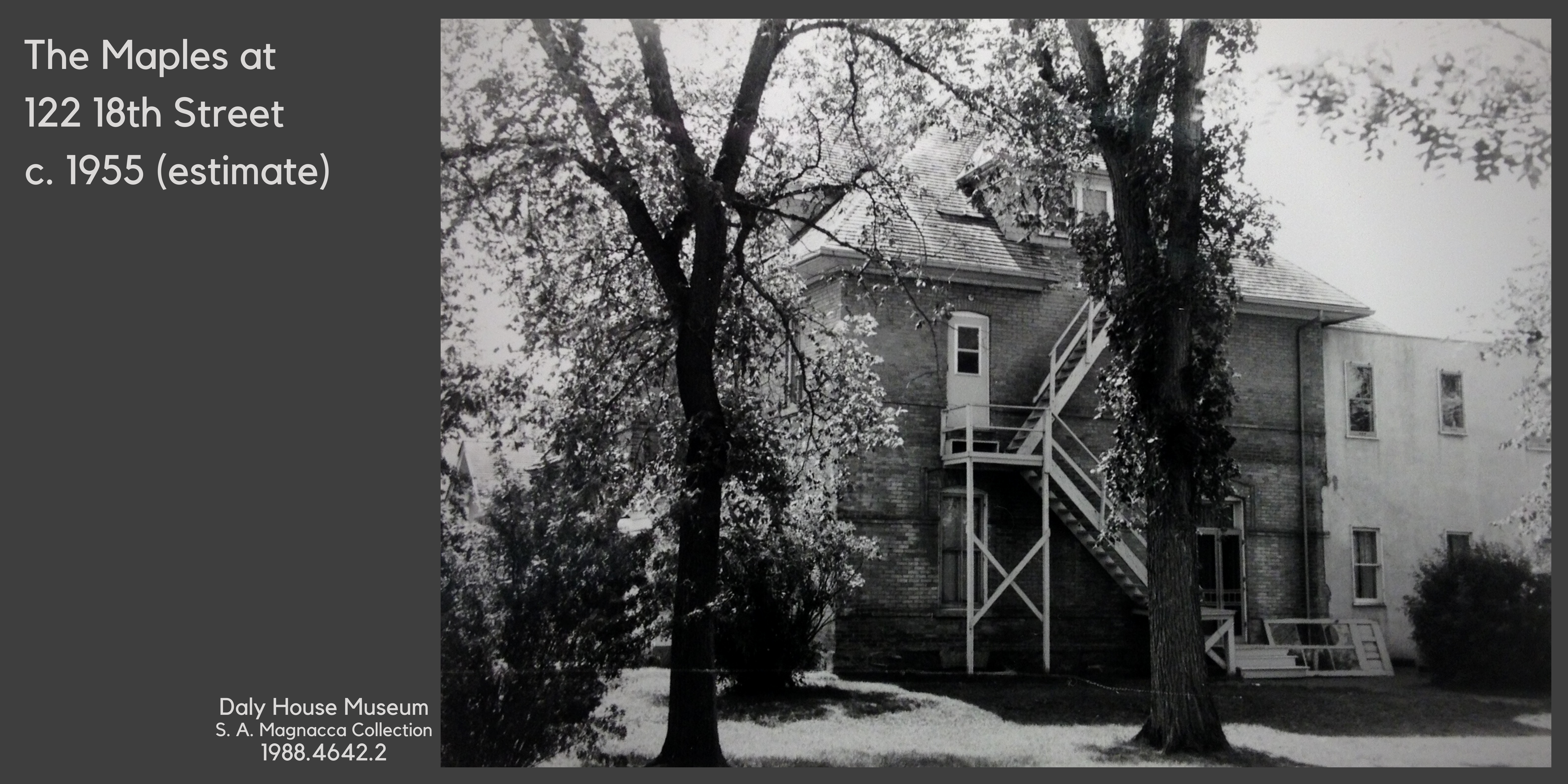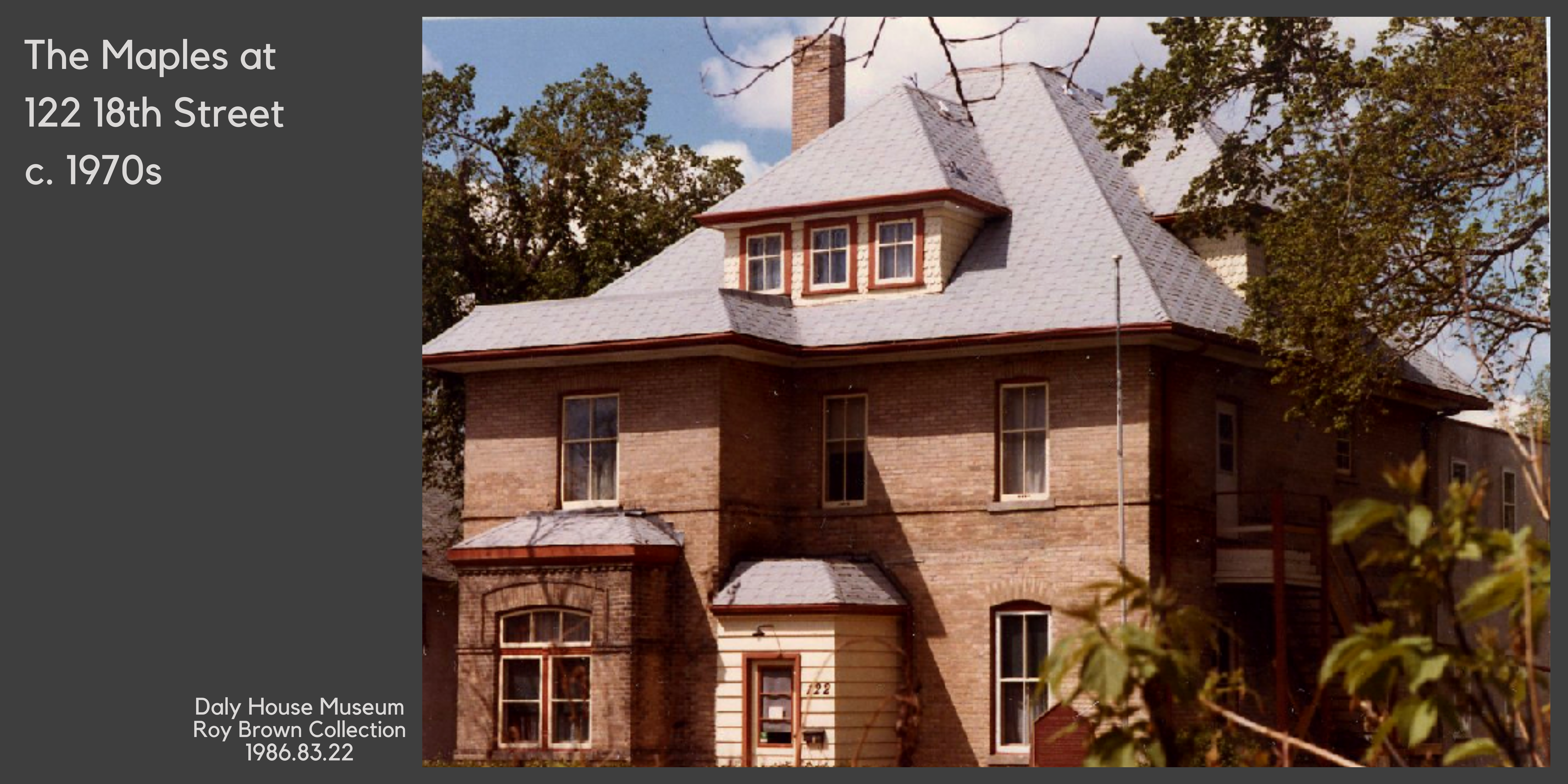Last updated on September 28th, 2022.
The Daly House Museum (Brandon Museum Inc.) recognises that the building the museum currently resides in is a place of trauma for many of those placed here during its time as The Maples Children’s Shelter. A warning that some details written and resources provided on this page may be triggering.
It is the job of a historical museum to educate and share history — not to censor or dilute it.
We are still actively recording the history of the time period that the Daly House was The Maples. If you have a story or photographs of The Maples that you are willing share with us please contact the Daly House Museum office.

The Maples
After the Coldwell family left the home in the late 1920s, the house was taken over by the City of Brandon and turned into a children’s shelter called The Maples in 1930. It was city-owned and administered by city-paid employees for the day-to-day operations, but childcare was done by professionals from the Children’s Aid Society. In 1967 it was fully turned over to the Children’s Aid Society of Western Manitoba by the City of Brandon.
The Daly House existed as The Maples for about 44 years and much of the records, documents, and photos for this era are regrettably long gone.
Children were placed in The Maples for a number of reasons — they were possible orphans, children of divorce with guardians unable to care for them during separations, or came from homes where caregivers were deemed unfit. Some lived at the shelter for less than a year, while others spent the majority of their childhood at the facility. Some returned multiple times throughout their childhood.
The Maples had strong connections to Brandon’s Residential School (1895 – 1972) as well as the Brandon Tuberculosis Sanatorium (1947 – 1961). The majority of children that passed through The Maples were of First Nation, Métis, and Inuit backgrounds.
The space was able to accommodate around 15 to 25 children between the ages of 2 to 13 years old. Those who lived at the Maples described it in a variety of ways — some described it as a temporary home and community, while others shared stories of abuse and discrimination.
In later years, The Maples was also referred to as a treatment center for “emotionally disturbed children”.
Support from the Children’s Aid Society provided case workers and counsellors for both children and parents, but the city still owned and managed the facility during this entire time. From 1959 to 1971 the Children’s Aid Society of Western Manitoba’s office was located in the building next to the Maples at 108 18th Street (sometimes listed as 118 18th Street, as the empty lot shared between 122 and 108 18th Street) and children would walk over to speak with councillors or have parental visits. They would later move into the new building for the shelter when The Maples was relocated after 1972.
Those that attended the children’s shelter would be assigned tasks around the house and have to help prepare meals in the kitchen. The majority of them would attend schools that had special programs available to assist them such as Linden Lanes, J. R. Reid, Park, and Meadows. Volunteers from the nearby Brandon College (Brandon University in 1967) would be paired with a child and spend a couple hours a week with them for some years.
Due to a bylaw to keep similar age groups together, when children reached the age of 13, they were required to leave The Maples. Some went to teenager group homes also run by the Children’s Aid Society in Brandon or in Portage la Prairie. Some were placed up for adoption and sent as far away as Australia, Europe, New Zealand, the United States, and throughout Canada.
In some cases, substantial amounts of money was exchanged within the provincial and federal government adoption programs for these children. A portion of these adoptions are considered part of the ‘60s Scoop. During these forced Canadian adoption programs, it is estimated between 20,000 and 40,000 First Nation, Métis, and Inuit children were removed from their families and communities and purposely adopted out into non-Indigenous households.
Survivors of the ‘60s Scoop include people who are registered Indians, as defined by the Indian Act, Inuit, and those eligible to be registered as Indians, who were removed from their homes between January 1st, 1951, and December 31st, 1991.
These children suffered a disconnect from their families and culture. Many are still grieving the loss of their childhood and this trauma can be passed on to following generations.
On the rare occasion, if it was allowed, children might be returned and reunited with their own families and culture. But the trauma of being separated during such critical learning years of their early childhood would be with them for the rest of their lives.

The House
When the City took over 122 18th Street with intentions to introduce a children’s shelter, many renovations had to take place to make it suitable. An additional bathroom was added and the basement area was converted into play rooms.
The boys’ and girls’ rooms, bathrooms, and indoor play areas were kept separate from each other, but they would have meals together as a group.
Later in 1950, a new wing was completed to provide more space for the children living in the building. This wing included an isolation ward/sick bay and an admitting unit. This also provided more space for indoor recreation for the children such as a crafts room and indoor sports such as floor hockey.
Additional renovations were made to meet fire safety regulations at the time. These renovations included removing the wooden wrap-around verandah (that was later restored in 2001 for the Daly House Museum), covering the hardwood floors with linoleum, and installing electric lighting.
The city and other sponsors used events such as the Royal Winnipeg Ballet and the Provincial Exhibition of Manitoba fairs to gather funds to help furnish The Maples during these renovations.
Despite these additions and renovations throughout the time of The Maples, the aging building was still considered to be in poor condition to be a children’s shelter for much of this time. Criticism for the state of the house would be brought up to City Council on multiple occasions for additional funding to renovate and repair over the decades.
So, not long after the Children’s Aid Society took over The Maples from the City of Brandon in 1967, they were seeking better and improved accommodations for the children. The building was showing wear and tear from the years and it was not a suitable environment for young children and expensive to upkeep.
In 1970, a new two-storey home for The Maples was opened at 2227 Brandon Avenue, which is still standing today (as of July, 2022). This new structure was only possible because of a donation by the late Frank E. Jacques of Forrest, a small community in the Rural Municipality of Elton just north of Brandon. A plaque to him was placed in the foyer of this new building, though today it has since been removed.
With this new building in place, in 1972 The Maples closed their doors at this location and the timeline of the Daly House moved to the next stage as the Daly House Museum.
Submitted by AJ Wowchuk
–
24 Hour National Residential School Crisis Line to provide support to survivors and those affected: 1-866-925-4419
Indian Residential School Survivors Society, for CRISIS SUPPORT from IRSSS 24/7 call toll-free at 1-800-721-0066
First Nations Health Authority, Indian Residential Schools Program
National Centre for Truth and Reconciliation, University of Manitoba
National Day for Truth and Reconciliation, Government of Canada
Why Do We Wear Orange? Orange Shirt Day, Every Child Matters [PDF]
Sixties Scoop | The Canadian Encyclopedia
The Brandon Indian Residential School Mobile Learning Centre
The Children Remembered, Brandon Residential/Industrial School
Indian Residential School History & Dialogue Centre, Brandon Residential School
–
Sources:
“Children’s Aid Body To Take Over Maples,” Brandon Sun, February 23rd, 1967
“Children’s Aid eager for building,” Brandon Sun, January 11th, 1969
“New home for deprived children,” Brandon Sun, November 13, 1970
“The story of the Children’s Aid Society,” Brandon Sun, May 26th, 1973
“Many children return to Maples to visit matron and staff,” Brandon Sun, July 7th, 1973
“’60s Scoop Survivors ‘cycle-breakers’,” Brandon Sun, April 22nd, 2019
“Survivors of ‘60s Scoop speak out during session,” Brandon Sun, February 1st, 2022
Daly House Museum (Brandon Museum Inc.) Collection
Henderson’s Brandon City Directories

Recent Comments